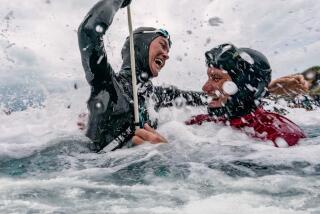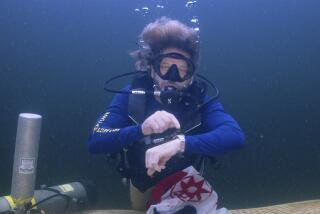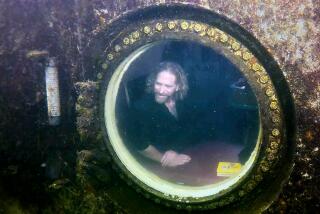WET & WILD : Gear Keeps Up to Keep Divers Down
- Share via
It was at a depth of about 60 feet that I first had trouble breathing.
Biting hard on the mouthpiece of my scuba regulator, I paused near a rock to concentrate on the task. If I stopped all extraneous movements, I could just eke out a long labored breath.
I knew from experience what that meant: I was almost out of air. As soon as the pressure inside the tank dropped below that of the water outside, any breathing would be impossible.
Yet experience also told me the antidote. By rising a few feet toward the surface, where the pressure was lower, I could grab another breath. And by repeating the process--taking a breath, rising, then breathing again--I could probably make it back to the boat, arriving with a bone-dry tank.
Back then, in the 1960s, “sucking your tank dry,” as it was called, was common practice. Scuba tanks, if they had any reserve system, were equipped only with an awkward valve that, when pulled, gave you a few extra minutes of air. The problem was that you had to reach way behind you to pull the valve, and half the time it was rusted shut. So rather than rely on it, most divers learned to assess how much air they had left by the difficulty they had breathing.
Fortunately, things are dramatically different. For starters, scuba training is much more elaborate and safety-oriented. Rather than taking a home-designed course in a backyard swimming pool, most divers today are trained by a certification agency whose courses are standardized and rigorous. The training emphasizes many cardinal safety rules, among them: Never end a dive with less than 500 pounds-per-square-inch of air in your tank, enough to last several minutes at the surface.
That goal is accomplished with a piece of modern equipment now standard among divers: an air-pressure gauge that attaches to a tank to give an accurate reading of how much air it contains. Some gauges even come with warning beepers that emit a piercing sound when the air gets below a certain pressure.
In addition, divers carry sophisticated depth gauges to assess their distance from the surface; automatic inflaters that, with the press of a button, fill their safety vests with air from their tanks to send them scooting upward in a pinch; and extra air sources for emergencies.
The surplus air sources usually take the form of extra “octopus” breathers attached to a single tank that divers can use themselves in case of equipment failure or hand off to buddies in distress. Other sources consist of miniature “booster” or “spare air” tanks carried on the belt or back containing enough air for a quick trip to the surface. And that trip is generally made more direct by use of an underwater compass to prevent unnecessary wandering and assure the diver of surfacing near a boat.
Many divers have even entered the computer age with sophisticated instruments that monitor the critical factors of a dive, giving them instant reports on their status.
My computer, no bigger than my hand, simultaneously monitors my breathing rate, tank pressure, current and maximum depth, surface time, underwater time and rate of ascent.
At any moment I can tell with a glance exactly how long I can stay at a particular depth before lack of air or nitrogen saturation--resulting in a case of the bends--forces me to the surface. Thus I can plan a dive scientifically, spending the maximum allowable time at the bottom and returning with a surplus of air.
In short, in the space of my own diving career, scuba has evolved from a “gonzo” sport engaged in by a handful of hardy athletes willing to brave its vagaries, to a recreational activity pursued with scientific precision by anyone willing to take the training and don a wet suit.


